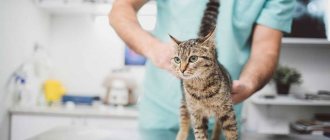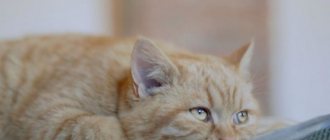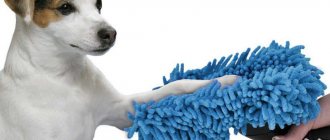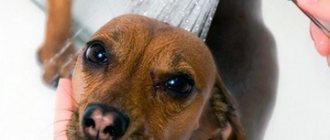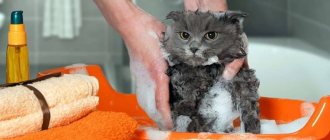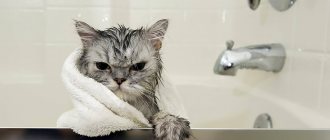Home » Cats » Rules for caring for cats » How to bathe a cat? » Let’s find out whether it’s possible to wash cats with tar soap, laundry soap, baby soap, or regular soap?
Pets need care and attention, so sometimes owners have to force mustaches to undergo water procedures.
Cats are not bathed often . As usual, the need for this manifests itself in cases where the cat, or rather its fur, is heavily soiled or there are other indications, such as the presence of fleas, ticks, and other parasites.
For water procedures, choose specialized weakly alkaline products intended strictly for animals. You can purchase the usual liquid shampoos, gels, shampoo sprays, caring balms and even gentle “cat” soap at veterinary pharmacies.
It is not recommended to bathe animals with human shampoos and ordinary laundry soap . Cat and human skin have different acid-base balance - in cats the pH varies between three and three and a half, and in humans it reaches six.
Therefore, it is not recommended to use non-specialized shampoo for cats. This is fraught with the development of allergies, the appearance of dandruff, dry skin, loss of elasticity and shine of the coat, and its loss. This does not yet take into account individual reactions and possible intolerance.
Can I wash my cat with regular soap?
Yes, if you can choose a product with an optimal PH level and track the quality and nature of the other components listed in the composition. It is not recommended to bathe a cat with regular soap or human shampoo for the reasons listed above.
Well-groomed hair is important for the cat family, so do not experiment, but use generally accepted and affordable shampoos located on the shelves of any veterinary store.
How to dry wool correctly?
Take the freshly washed cat into the room and dry it with a towel. For short-haired cats, one towel will be enough, and for long-haired cats, do not skimp on 2-3 pieces. You can place your pet on a newspaper or hoe so that the dripping moisture is absorbed faster.
For your information: a cat has a so-called air cushion between its skin and the top layer of fur. This layer of air is heated by the animal's body heat and protects the cat from freezing. During bathing, the fur gets wet and temporarily loses its thermoregulatory properties, which is why it is so important to warm the cat with towels after washing and protect it from drafts.
If the cat is not afraid of a hair dryer, then about 10 minutes after bathing you can lightly dry his fur. The air flow should be warm, but not hot. If the cat is afraid of electrical appliances, it is better to wait until the “coat” dries naturally.
https://www.youtube.com/watch?v=ytcopyrightru
Use a special comb to comb the fur.
After washing, your domestic cat needs to stay warm for at least an hour.
Is it possible to wash cats with tar soap?
Tar soap, according to many breeders, is a real panacea in the fight against blood-sucking insects. Let's see if this is true. Any animal, even if it is completely domestic, has been infected with fleas at least once in its life, the larvae of which you could bring home on clothes and shoes. Pedigree cats, as well as show cats, are vaccinated against blood-sucking insects once every three months, and special notes are included in the veterinary passport.
Tar soap is a very primitive, cheap, but effective way to combat invasion . Thanks to the phenols, alkalis, citric acid and sodium salts it contains, soap repels insects. Benzene contained in birch tar has a paralytic effect on the nerve centers; alkali has an antiparasitic effect, burning through the shell of parasites.
In relation to insecticidal (antiparasitic) agents, soap with a tar component has a number of advantages:
- Absence of poisons, alkaloids of hazardous substances and heavy metals. Many modern parasite control products contain toxic substances, which is why they should be dosed and used with caution.
- It is allowed to use in the presence of wounds, abrasions, and other skin diseases.
- Tar soap can be used to treat animals against parasites as early as six to eight weeks of age, because it does not dry out the skin and maintains water balance. Even in human medicine it is prescribed as a prevention of skin diseases.
- The biggest danger of using tar soap is that its foam gets on the mucous membranes, as well as in the eyes and ears. Modern insecticidal preparations, when licked by animals, can cause severe forms of poisoning, paralysis and even death.
How to wash a cat if there is no special shampoo
For regular care of animals, special products are needed. They are less aggressive in composition than regular shampoos. It is best to wash the cat with warm water and beaten egg yolk. If that doesn’t work, you need compounds with PVA.
In rare cases, you can wash cats with regular shampoo or soap, but it is not advisable to do this often. The animal's skin will begin to peel off.
Let's discuss what to choose from what is in the bathroom.
Regular soap
It is not recommended to bathe a kitten with soap with a strong fruity or floral aroma. Bath, pine, and baby soap are preferable. Experienced veterinarians do not advise excessive soaping of the animal.
It is enough to pour it with soapy water or apply foam to the wool. If the surfactants (surfactants) don't touch the skin, great.
You shouldn't bathe your pet too hard. He must have natural protection.
Baby shampoo
Products used to wash children under three years of age are hypoallergenic. They contain less of all kinds of synthetic additives and more natural ingredients. But you can’t get carried away with them either.
The product is pre-diluted 1:3 and foamed well. And then the kitten is treated with foam. You need to carefully clean the face.
Phrases like “washes without tears” are a marketing ploy. When foam gets into the eyes of animals, conjunctivitis develops. The small pet will become restless. Ears are a no-go area. They are cleaned with ear sticks with water, lotion or saline solution.
Regular human shampoo
Some owners use human shampoo to care for their pets, and do this regularly. Veterinarians strictly prohibit doing this. The secretion of fatty glands is disrupted, the skin suffers, and the structure of the hairs changes.
Allergic dermatitis and other skin diseases are possible. Immunity weakens. After washing, cats get sick more often and can get pneumonia.
If there are several hair care products, choose the simplest one. It is better if it contains a decoction of herbs, without dyes or thickeners.
The soap composition is made by diluting the shampoo with water, increasing the volume at least five times. In this case, it will be possible to protect the cat from the consequences and reduce the risk of developing skin diseases.
Tar shampoo or liquid soap
Tar is an excellent folk remedy for skin irritation. Liquid soap or tar shampoo is a good insecticidal remedy for blood-sucking insects.
If your pet constantly scratches itself with its paws or bites something out of its fur, it may have fleas. Try washing it with tar soap. This primitive method is used in folk medicine.
Is it possible to wash a cat with laundry soap?
Constantly is not possible. Laundry soap has a very hard and heavy structure for cat skin. After using it, dandruff is likely to appear . You may notice other allergic reactions.
It is acceptable to use laundry soap once, in extreme cases, when the animal needs to be bathed urgently, and there is nothing more suitable at hand.
DIY flea repellent
Folk remedies are sometimes used to rid a four-legged pet of parasites. They are non-toxic, safe and will not harm your pet if accidentally ingested. Flea shampoo for cats is easy to make yourself. It is prepared as follows:
- grate 30 grams of laundry soap;
- soap shavings are diluted with 15 grams of water;
- add 5 drops of cedar, lavender or peppermint essential oil to the mixture;
- the product is heated on the stove until a homogeneous mass is formed.
This is interesting: Gray parrot callus what to smear
The resulting shampoo repels pests for 1 - 2 weeks. After bathing, it is necessary to examine your pet for allergies, since he may be intolerant to any of the components of the drug.
When choosing a product to kill fleas on a cat, you should be careful and careful. It is worth using only proven drugs and carefully monitoring your pet’s well-being after treatment, and regular prevention will allow you not to worry about the presence of harmful parasites in your furry pet.
Is it possible to wash a cat with baby soap?
If there are no special products for animals on hand, the use of baby soap is not prohibited, especially if it is a hypoallergenic product for the little ones. Shampoos for children are also acceptable, but it is important to remember that the phrase “does not cause tears” is nothing more than an advertising ploy.
When bathing your pet with baby products, take all precautions and be careful not to get soapy water and foam into your eyes, ears, or mouth. Do not overdo it when giving your animal water treatments with baby shampoos. Even the highest quality and most expensive baby soap can negatively affect the skin, causing rashes and allergies.
The widespread production and use of animal detergents is not a simple marketing ploy, but an urgent need. Don’t lose sight of the body’s individual reactions.
If you find it difficult to choose a shampoo or other product that helps bathe your pet, or you encounter allergic reactions and malaise after water treatments, contact the nearest veterinary clinic, you can call.
Qualified personnel will provide the necessary consultations and advice.
Dust soap against fleas
Dust soap Dust soap for fleas in cats used to be especially popular. The drug was universal for removing lice, nits, fleas and other pests. It contains a powerful toxic substance that can penetrate the chitinous cover of an insect and thereby contribute to its death.
This is interesting: How a cat clicks its lower jaw and drools
For this reason, dust soap for fleas in dogs and cats is not used. Its use can lead to intoxication of the animal and even its death. At the same time, it is recommended to carry out disinfestation in the house or apartment or treat the premises yourself, using the best commercially available products.
Dust soap is a regular laundry soap that contains dichlorodiphenyltrichloromethylmethane (DDT for short). This is a toxic substance that can penetrate the chitinous cover of insects. DDT accumulates in the body of an arthropod and, at a certain concentration, kills the pest. That is why it is often used to combat lice and fleas. DDT can kill parasites on the human body
A special feature of DDT is its ability to penetrate through the shell of eggs, not only through the chitinous cover, so the poison accumulates in the body of unhatched “cubs”, thereby destroying the entire population of parasites at once. Thanks to this, dust soap is more effective than many other products.
In addition to this poison, dust soap has a sharp, terrible odor that frightens insects and makes them run away from the source of this “aroma.” Thus, the parasites leave the body of an animal washed with dust soap either alive, frightened by the smell, or dead - straight to the next world. DDT will kill even a malaria mosquito
If you need to wash an animal or person at least twice with laundry and tar soap, then one procedure with dust soap is enough. Moreover, doctors do not recommend using this product frequently, since DDT accumulates in both the human and animal body, which can lead to intoxication. Dust soap is similar in appearance to laundry soap
Dust soap is strictly prohibited for use by pregnant women (both women and female animals), since DDT can cause various pathologies in the fetus. Also, it cannot be used for children (in the case of animals - up to one and a half months), since the substance can disrupt the functioning of the nervous system and brain. Children's immune systems are weak and there is a risk of developing cancer.
- with one-time use it has a calming effect;
- penetrates the chitinous cover and shell of insect eggs, killing them;
Disadvantages of this product:
- high level of toxicity;
- DDT can accumulate in the human and animal body and lead to serious damage to many body systems;
- dangerous for children (both human and animal);
Bathing process
By following certain rules, cat bathing can be made comfortable. It is advisable to carry out this procedure with a partner. One will hold the animal, the other will wash the pet.
For this process you will need:
- medium-sized shallow basin;
- ladle;
- pan with warm water;
- nail clipper;
- sponge;
- brush;
- cotton wool;
- detergent;
- terry towel;
- hair dryer;
- treat for the cat.
The first time you bathe a kitten, you need to be careful; by this time, it should get used to its owners and trust them. The step-by-step washing process will look like this:
- Before bathing, you should trim your pet's nails to avoid being scratched by an angry little predator.
- Place the basin in the bath and place a saucepan next to it. Pour warm water into both containers to a height of approximately 2-3 cm. Its temperature for a comfortable bathing of the pet should be from 30 to 38 ° C, considering that the cat’s body temperature is higher than human. A small basin will be needed so that the large size of the bath with water does not cause panic in the baby. You need to bring a towel into the bathroom in advance and open the bottle of detergent.
- Plug the animal's ears with cotton swabs soaked in vegetable oil to prevent water from getting inside. After this, bring the cat into the bathroom.
- Take the baby by the withers with your hand (this is where the cat picks up the kittens when she moves them to another place) and put them in the basin. You can wash it in any position - standing or lying down. If the kitten panics, you should not pay attention. You need to talk to him calmly, stroke him, showing that everything is going fine.
- Then use a wet sponge to go over his fur, starting from the neck and slowly moving towards the tail. It is important to follow this sequence of movements so that fleas (if any) come into contact with water and run towards the tail and not into the pet’s eyes. You need to try not to frighten the animal with random noise, calm it down, talk to it affectionately.
- Pour a few drops of detergent into your palm and rub it into the cat’s fur all over the body with gentle massaging movements. It is better not to get your pet's head wet, as it may become frightened, and there may also be problems with the ears (otitis media).
- Carefully remove the resulting foam from the kitten with a brush. After this, put the cat in a basin and pour clean water from the ladle, poured into the pan in advance, holding the baby with your hand so that he does not jump out of the container. He will be much calmer if he can grab onto something in the basin. Wipe the outside of the ears and eyes with a damp hand.
- After completing the procedure, wrap the baby in a large towel to remove excess water from the fur and contain the baby, since a wet kitten can run away and become hypothermic. There is no need to rub it with a towel, this will harm the fur. To prevent the baby from catching a cold after water treatments, there should be no drafts in the house while the pet’s fur is drying.
- Step 9. To dry the fur faster, it is advisable to place the pet in a warm place, for example, near a radiator. To speed up the drying process, since the animal’s fur will dry completely only after 12 hours, you can use a hairdryer. To do this, you need to keep the buzzing device at a distance of at least 30 cm from the cat’s body.
- Brush the baby's fur with a special brush or comb, removing all dead hair.
- After drying and combing, the kitten is calmed down and treated with a treat, so that in the future he associates washing with pleasant moments.
This is interesting: Staphylococcus aureus in the nose of a dog
The washing process must be carried out quickly (in 5-7 minutes). It is better to take shampoo without fragrances, since the kitten will mistake any scent for dirt and will take a long time to lick it from its fur.
If you know how to wash a kitten correctly for the first time and approach this procedure responsibly, then in the future “bath days” will not cause your pet to have negative reactions and a reluctance to bathe.
Allergic dermatitis and other skin diseases are possible. Immunity weakens. After washing, cats get sick more often and can get pneumonia.




